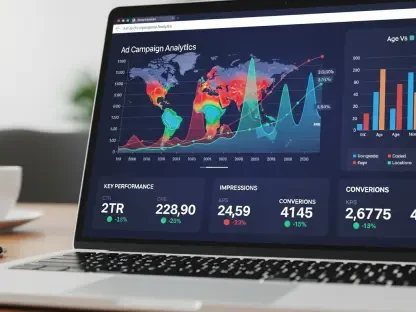In today’s fast-paced digital landscape, companies are constantly competing to capture and retain customer attention. The evolution of search technology and the rise of generative engine optimization (GEO) have added new layers of complexity to this process. Understanding and mastering search engine optimization (SEO) has become crucial for businesses aiming to stand out. Marketing teams spend millions to ensure their brand remains prominent, often unaware of the aggressive tactics competitors use to gain an edge. If businesses do not strategically manage their digital presence, they risk losing customers to more proactive rivals.
1. Evaluating your online presence: Investigate where and how your brand shows up in search results
Most companies believe that competitor advertising is something others engage in until they discover it’s already impacting their business. Search engines like Google employ advanced algorithms to broaden keyword matches. This means your brand might appear in search results for a competitor’s name, even if you never intended it to. With Google expanding its definition of “close matches” in paid search, your brand name or similar terms might inadvertently trigger a competitor’s ad. Simple variations or typos of a brand name can easily result in users being directed to rival businesses.
For businesses without a formal brand protection strategy, this serves as a wake-up call. Failing to actively manage your search presence allows competitors to exploit your brand, driving traffic away from you. To be competitive, companies must evaluate their online presence meticulously. Understand where and how your brand appears in search results and identify any unintended overlaps with competitor keywords. This proactive approach helps prevent potential customer diversion, ensuring your brand remains at the forefront of relevant searches.
2. Invest in precise SEO: Enhance your brand by focusing on vital keywords
Investing in precise SEO involves more than just optimizing for search engines; it’s about understanding customer behavior and intentions. Prioritizing vital keywords, especially those customers use when comparing brands or searching for alternatives, is essential. By bidding on strategic keywords and refining your SEO strategy, you can elevate your brand’s visibility and authority. This not only helps attract new customers but also retains existing ones by ensuring they find you easily in search results.
SEO today demands a nuanced approach, focusing on intent-driven keywords. This involves analyzing search trends and customer journeys to identify the terms that matter most. Incorporating these insights allows companies to create content that resonates with potential customers. Moreover, continuous monitoring and adjusting of SEO tactics ensure sustained relevance and competitiveness in the digital space. By prioritizing specific keywords and refining content strategies, businesses can secure a prominent position in search results, driving more qualified traffic to their websites.
3. Embrace GEO tools: Use AI-driven technologies that refine your content for a more intuitive, conversational search experience
GEO represents the next frontier in search technology, providing an AI-driven approach to optimize content for more intuitive, conversational search experiences. Unlike traditional SEO, which focuses on keyword optimization, GEO leverages artificial intelligence to generate search results that better align with user intent. This transformation helps shape online narratives by presenting brands in more dynamic and personalized ways before users even click through to a website.
Consider a scenario where a user searches for information about a product in your category. An AI-generated answer might highlight a competitor as a superior alternative if your content isn’t optimized for GEO. This emphasizes the importance of embracing GEO tools to ensure your brand stands out in these AI-driven search results. By leveraging technologies that refine content for natural, conversational queries, businesses can position themselves as top choices in their respective industries.
Additionally, GEO tools provide insights into user behavior and preferences, enabling brands to tailor their marketing strategies more effectively. By integrating AI-driven tools into their digital marketing arsenal, companies can create more engaging, contextually relevant content that meets the evolving expectations of modern consumers. This proactive approach not only enhances user experience but also fortifies brand loyalty, making GEO an indispensable component of contemporary digital strategies.
4. Start a brand protection initiative: Create a detailed plan to monitor and handle your brand’s online representation
A comprehensive brand protection initiative is critical in safeguarding your digital territory and preventing competitors from exploiting your reputation. Developing a detailed plan involves continuous monitoring and management of your brand’s online representation. This strategy should include keeping track of how your brand is advertised, ensuring it aligns with your intended image, and blocking unauthorized usage of your keywords by competitors.
Protecting your brand extends beyond reactive measures; it involves proactive steps to control how it appears across various digital platforms. Regular audits of your online presence help identify potential threats and vulnerabilities. Implementing tools and technologies to track and manage your brand’s visibility ensures that competitors cannot misappropriate your brand name to drive traffic to their sites. Establishing clear guidelines and protocols for online representation further strengthens brand integrity.
Moreover, a well-executed brand protection campaign involves collaboration across multiple departments, including marketing, legal, and IT. This collective effort ensures comprehensive coverage and swift responses to any threats. By maintaining vigilant oversight and enforcing robust protection measures, companies can preserve their brand reputation, foster trust with customers, and maintain a competitive edge in the digital marketplace.
Preparing for the Future: The evolving landscape of competitive search marketing
In the current fast-paced digital landscape, businesses face growing competition to capture and retain customer attention. The advancement of search technology and the emergence of generative engine optimization (GEO) have introduced new and complex challenges. As a result, mastering search engine optimization (SEO) has become vital for companies aiming to distinguish themselves from the competition. Marketing teams invest millions to keep their brand visible, often unaware of the aggressive tactics used by competitors to gain an edge. Without a strategic approach to managing their digital presence, companies risk losing customers to more proactive rivals. In this dynamic environment, businesses must continually adapt their strategies, utilizing the latest SEO techniques and technologies to maintain a competitive edge. The digital era demands constant vigilance and innovation, as falling behind can lead to significant loss in market share. By staying ahead in SEO and GEO, businesses can navigate the complexities of the digital world and ensure their sustained growth and visibility.









